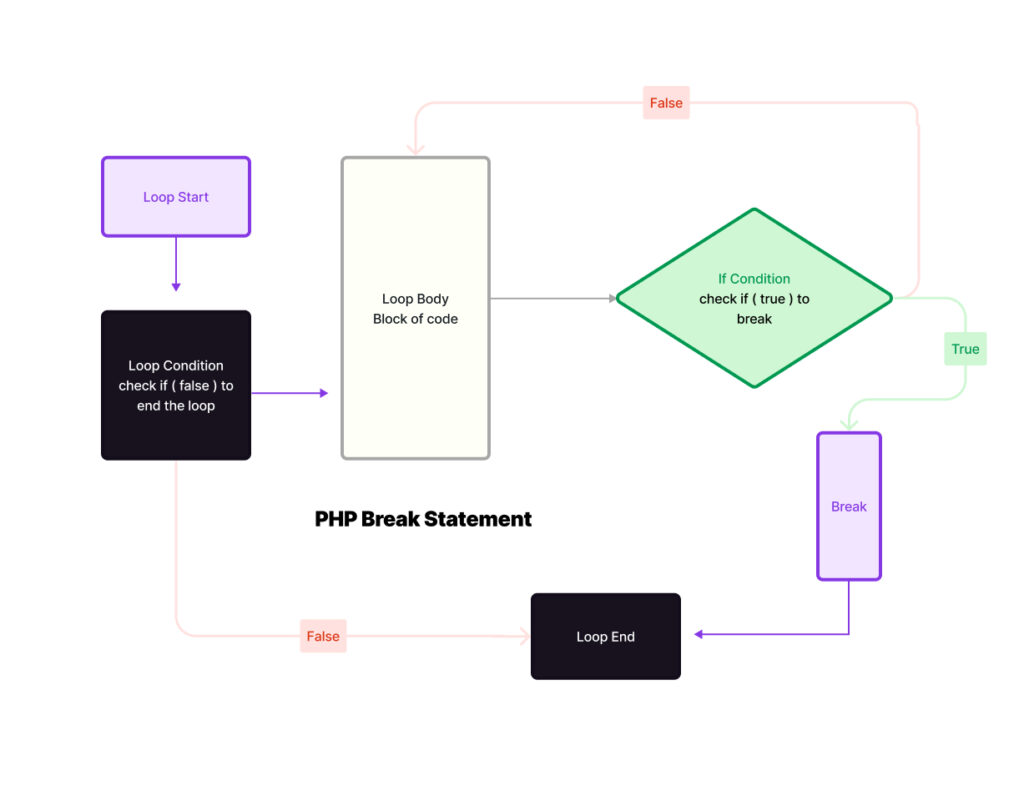The PHP break statement is employed to prematurely terminate iterations in PHP loops (such as for, foreach, and while) when specific conditions are met, providing control over the flow of code execution.
Table of Contents
In this article, we’ll explore the syntax, usage, and various applications of the break statement in PHP.
PHP break Statement Syntax
The PHP break statement is used to exit from a loop before its normal termination. It is commonly employed in situations where a specific condition is met, and further iterations become unnecessary.
Here is the syntax:
while (condition) {
// code block
if (condition_to_break) {
break;
}
// more code
}The break statement is integrated into a while loop. If the specified condition is met within the loop, the break statement is executed, causing an immediate exit from the loop and skipping any remaining iterations.
Let’s understand exactly how it works.
How Does the break Statement Work in Loops?
Here is a figure that shows you how it works.

In this flowchart:
- The loop starts, and the loop condition is checked.
- If the condition is true, the loop body is executed.
- Inside the loop body, there is a check (if condition) to determine whether the loop should be exited prematurely.
- If the condition for the
breakstatement is true, thebreakstatement is executed. - The control flow immediately exits the loop and continues with the next statement after the loop.
This flowchart represents a generic loop structure with a break statement. Depending on the type of loop (e.g., while, for, foreach), the specific syntax and initialization may vary, but the general flow remains the same. The break statement allows you to exit the loop based on a certain condition.
For a better understanding, follow the examples below.
Using break in Different Loops:
Using break Statement in “for” Loops:
<?php
for ($i = 0; $i < 10; $i++) {
// code block
if ($i == 5) {
break;
}
// more code
}This “for” loop runs from $i = 0 to $i < 10. When $i becomes equal to 5, the break statement is triggered, and the loop is exited prematurely.
Let’s explore another example using a different type of loop.
Using break Statement in “while” Loops:
<?php
$i = 0;
while ($i < 10) {
// code block
if ($i == 5) {
break;
}
// more code
$i++;
}In this “while” loop, the condition is checked before each iteration. When $i becomes 5, the break statement is executed, and the loop exits.
We can also use the break statement with a do-while loop; let’s see how it works.
Using PHP break Statement in “do-while” Loops:
<?php
$i = 0;
do {
// code block
if ($i == 5) {
break;
}
// more code
$i++;
} while ($i < 10);This loop checks the condition after executing the code block. The break statement can still exit the loop based on the condition.
Anyway, let’s look at an example of how to break out of a PHP foreach loop.
Exit the PHP foreach Loop
<?php
$numbers = [1, 2, 3, 4, 5];
foreach ($numbers as $number) {
echo $number . ' ';
// Check if the current number is the one we want to stop at
if ($number == 3) {
echo "(Found 3, exiting loop)";
break; // Exit the foreach loop
}
} // Output: 1 2 3 (Found 3, exiting loop)In this example, we used the foreach loop to iterate through an array of numbers. The objective is to exit the loop once a specific value (in this case, 3) is encountered. Within the loop, an if statement checks whether the current number is equal to 3. If this condition is met, a message is printed to indicate the discovery of the value 3, and the break statement is employed to exit the loop prematurely. This approach allows for the efficient termination of the loop when a specific condition is satisfied.
We can also stop the two nested loops using the break statement. Let’s move to the last example to understand it.
Nested Loops and break Statement:
<?php
for ($i = 0; $i < 5; $i++) {
for ($j = 0; $j < 5; $j++) {
// code block
if ($j == 3) {
break 2; // exit both loops
}
// more code
}
}When dealing with nested loops, specifying the number after break indicates how many levels of loops to exit. In this example, break 2 exits both the outer and inner loops when $j is equal to 3.
Let’s summarize it.
Wrapping Up
The break statement in PHP is a versatile tool that empowers developers to exert precise control over loop execution. Whether employed to prematurely exit loops, skip certain iterations, or gracefully handle errors, the strategic use of break contributes to code efficiency and readability.
Understanding the nuances of break within different loop structures, including “for,” “while,” and “do-while” loops, allows developers to tailor its application to specific scenarios. Moreover, the ability to navigate nested loops using the break statement enhances the flexibility of loop control.
The conditional use of break provides a mechanism for dynamic loop termination, allowing developers to respond to changing conditions within the loop’s execution. Furthermore, in conjunction with the switch statement, break ensures the intended flow of control through case structures.
Effective error handling is another facet of the break statement, enabling developers to gracefully exit loops in the presence of errors, fostering robust and maintainable code.
Thank you for reading. For more PHP tutorials, visit here.